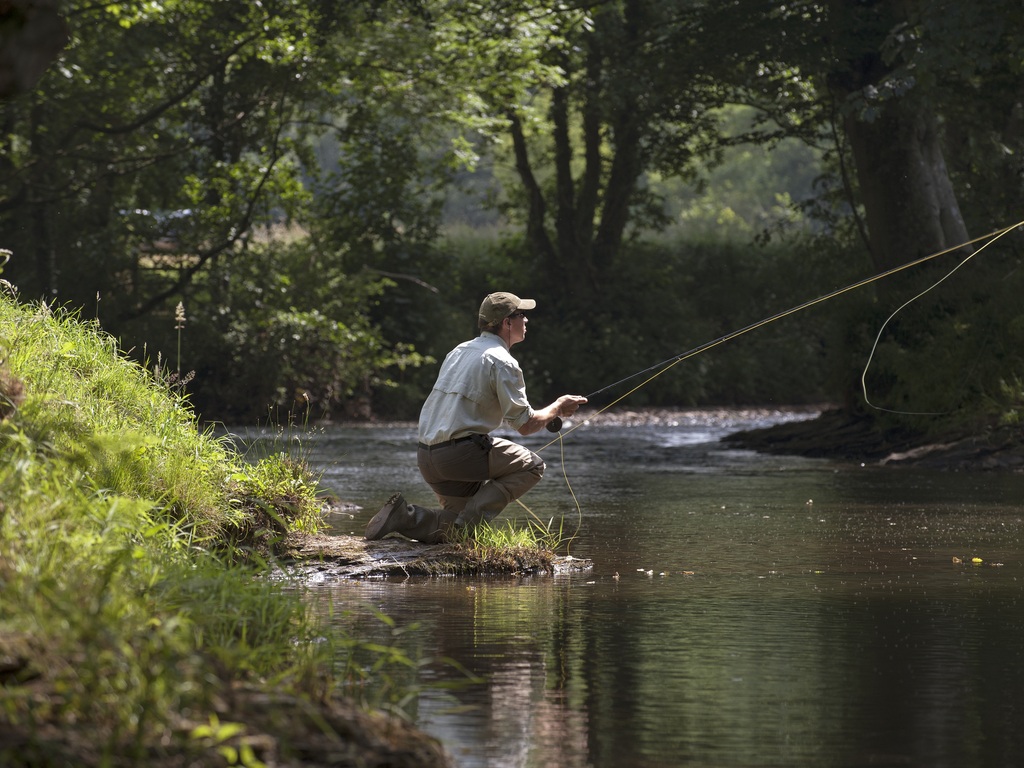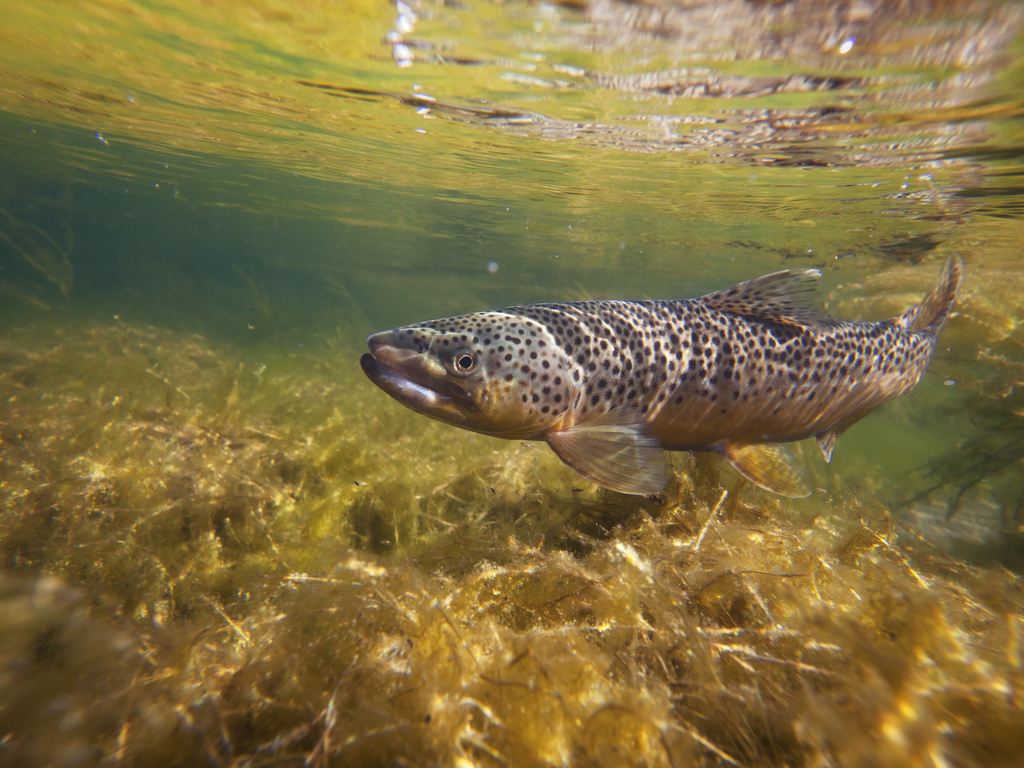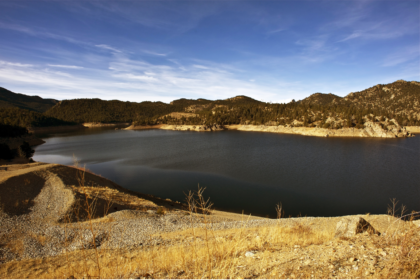Brown trout are a popular sportfishing species found in water bodies over the United States. There are certain techniques to use and times that are best in order to maximize your catch quantity and quality. Wondering how to catch brown trout? Look no further.
In this complete guide of fishing for brown trout, we will cover how to catch trout in the different habitats where they dwell, using different fishing techniques, during different times of the year, and using different kinds of bait.
How to Catch Brown Trout in Rivers
Brown trout populate many rivers across America, but all of them display the same predictable habits. Brown trout like cold, oxygenated waters, so they are easy to find in deep pools adjacent to fast-moving currents. This species is also particularly fond of sheltered areas and shying away from the light.
Any shaded spots such as below undercut banks or behind large river boulders are the best places to find brown trout. Fishing on cloudy days and during the night for this species also proves effective due to their light sensitivity.
Flyfishing tends to be the best method to fish for brown trout in rivers. Weighted lures that are flashy and reflective, especially in murky water or at night tend to be the most successful. Fast-moving lures seem to make brown trout slightly wary so avoid those in order to prevent spooking the fish.
How to Catch Brown Trout in Ponds
Brown trout behave differently in open water such as ponds than they do in rivers and streams, but they are attracted to the same optimal conditions. Trout are constantly in search of cold oxygenated waters which provide a great habitat as well as lots of opportunities for food.
In a pond or reservoir that is connected to a moving source of water, brown trout tend to gather near the inlets and outlets. In the open water, however, they will stick to the sweet spot where deeper cold waters mix with warmer surface waters to provide a stable environment for nutrients and food sources.
During the summertime, fishing in deeper waters is more effective to find brown trout. When the surface water cools down, the brown trout will move higher up in the water column. You will need a heavier weight for deeper water fishing.
Once you locate where the fish are, you should have no problem pulling up large quantities as they will gather where conditions are optimal.
How to Catch Brown Trout Using Spinners
Trout fishing with spinners is most effective when fishing for brown trout in a lake, pond, or reservoir. There are a few things to keep in mind when using spinners for trout fishing. Spinners should always be spinning when you are fishing for brown trout or else the fish will not bite.
Some anglers begin to reel their line in as soon as the spinner hits the water. This is perfect if the brown trout are at the surface, but oftentimes, they are much deeper.
If you count each second that the lure sinks before beginning to reel, you will get an idea of how deep you are fishing. Each second represents ten feet of water so when you hook a brown trout, you’ll know how deep to cast next time.
Extending out your radius of casting to encompass the waters all around, not just in front, of you will also help make your spinning technique more effective.
How to Catch Brown Trout by Ice Fishing
The first step to ice fishing for brown trout is locating them beneath the ice. Most brown trout tend to aggregate near structures and can be found fairly shallow after first ice. Later in the season, they may migrate to deeper waters.
Because visibility within the water column tends to be low due to overcast days and thick layers of ice and snow, you’ll want to use a lure and fishing technique that will catch the brown trout’s attention.
Jigging spoons are typically the best lure for ice fishing for brown trout. They are flashy and reflective and will attract the brown trout as if it’s chasing a shiner. Using the jigging technique will help attract even more attention and mimic the natural movements of the brown trout’s prey.
How to Catch Brown Trout by Flyfishing
Fly fishing for brown trout is most effective in fast-moving waters such as rivers and streams. The fly fishing technique mimics the movements of brown trout’s preferred insect prey. Casting your flies so that they target rising fish by using sub-surface lures is a wonderful technique to hook a brown trout.
Even though there are hundreds of different flies to choose from, no one fly is the ultimate winner. The right fly to choose depends on the location and season of your fishing spot. You’ll want to investigate what insects are hatching in order to know how to match your flies to the shapes and colors of the brown trout’s seasonal prey.
Stoneflies, midges, caddisflies, and crayfish are all very popular flues to use when angling for brown trout. Some other flies which offer a high rate of catch for brown trout include woolly buggers, pheasant tail nymphs, San Juan worms, hares ear nymphs, rubber-legged skunks, and rabbit strip streamers.
Brown trout also love the delicacy of eggs, especially salmon eggs when they’re in season. It’s a good idea to keep some real or imitation eggs to fish for brown trout because those are sure to be a winner.
Trolling for Brown Trout Techniques
Trolling for brown trout is a great way to haul in a good catch if you are fishing in open waters such as a lake or pond. With this method, you can cover a wide area as well as a decent range of the water column while you let the movement of your line do all the work for you.
Always remember to keep your line tight. Slack in the line will affect how your lure acts. It can cause it to lose momentum and you to lose control of where it’s at. When you troll, make sure you’re in a clear area. Weedy bottoms or places with lots of logs or debris in the lakebed may cause your line to get snagged.
Start your trolling by letting out about fifty to a hundred yards of line behind your vessel. Then, slowly move through the water while keeping an eye on the bobber for any bites. Canoes or kayaks work well for trolling; you just need to keep up a pace of about one to two miles per hour.
Motor-powered vessels are good for trolling too as long as you maintain a slow speed. Going too fast will cause your line to rip through the water and may deter any brown trout from biting as they will determine that your lure is moving too fast to be worth chasing.
Best Time to Catch Brown Trout in the Summer
The best time of day to catch brown trout during the summer is either at dawn or at dusk. Brown trout typically feed around the rising and setting of the sun. They will be more active and more willing to bite.
If you begin your fishing about an hour before the sun rises and fish until about an hour after the sun has peeked over the horizon, your chances are good of hooking some trout. Likewise, fishing for about an hour on each end of the sun’s setting will be fruitful trout fishing.
Since brown trout are cold-water fish, they will most likely find deep cooler water pools to hang out in during the heat of the day. Especially in the middle of the summer, brown trout activity slows way down because the fish become extremely sluggish.
Dusk and dawn offer relief from the harsh sun and warm surface water so brown trout will take advantage of the opportunity, which means you should take advantage of the fishing.
Best Time to Catch Brown Trout in the Fall
As the temperature begins to drop in the fall from the blazing summer heat, brown trout will become more active during larger portions of the day.
At the beginning of autumn when temperatures may still be fairly warm, fishing around dawn is your best bet to catch brown trout. They will be actively feeding and may stay active or migrate to deeper pools if the sun heats up the surface water too much.
In late fall when temperatures stay below fifty degrees Fahrenheit (ten degrees Celsius) consistently, brown trout will continue to be active for longer periods throughout the day. In this case, the best time to fish is from the afternoon to early evening. The second best time is in the middle of the morning.
Trout will still tend to be less easy to find during midday in the fall, although your window for catching brown trout will be much larger than during the summer.
What Do Brown Trout Eat?
Brown trout are opportunistic feeders with a wide variety of diets. Land and water insects make up a large portion of their diet due to hatches that commonly occur in and around where they live. Brown trout will also not hesitate to eat crayfish, snails, small clams, worms, and zooplankton.
Brown trout can be cannibalistic eating younger trout and also smaller fish species such as minnows, sculpins, and darters. If a brown trout grows large enough, it can target slightly larger prey such as small turtles or mammals.
One of the brown trout’s favorite foods is salmon eggs. Trout that live in the same rivers and streams as salmon will feed mostly on salmon eggs when they are in season.
What to Catch Brown Trout with?
Since brown trout will eat almost anything within the size range small enough to fit in their mouths, the choices of bait to fish for brown trout is virtually endless. Things to consider when choosing the right bait or lure are the area in which you are fishing and the season you are fishing in.
For still open water conditions such as those found in a lake, pond, or reservoir, spinners and crankbaits are extremely effective. Using lures that imitate the natural fauna of the water body such as baitfish, leeches, insects, and other small fish will be particularly favorable to catching a brown trout.
For moving waters such as rivers and streams, it would be in your best interest to research what insects are hatching during the time of year you choose to fish. Matching your lure type with the seasonal hatch will increase your chances of snagging a brown trout.
For trout waters that also harbor salmon, salmon eggs should be your number one bait for brown trout. Brown trout thrive on salmon eggs during the season so fishing with real or imitation eggs is sure to land you a decent catch.
Flashy and reflective lures that mimic minnows and shiners are always a good bet as long as you don’t troll or fish them too fast. Brown trout are opportunistic but tend to be lazy if their prey is moving too fast to be worth catching.
How to Catch Brown Trout with Worms?
Fishing for trout with worms is a highly efficient method in any type of water especially in the spring when the cold waters of winter begin to warm up. If you are fishing for trout in a lake, pond, or high water river, it’s best to use a bigger worm that you can hook through the middle.
This will allow both ends of the worm to wriggle freely and attract the attention of a brown trout looking for a meal. For low water streams, you only need a small piece of worm, just large enough to cover the entire hook. The smell of the worm will attract the trout more than any thrashing movement.
Worms are a wonderful way to fish for brown trout in any season or water and are usually one of the cheapest forms of bait.
Check out our article for a comprehensive guide on catching all types of trout.




